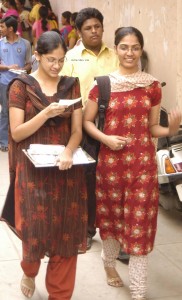 SSC Public Examination
SSC Public Examination
Physical Sciences Model Paper
Paper 1 – Physical Sciences
PART A and B
TIME: 2.30 HOURS MAX. MARKS: 50
Instructions:
1. Answer the questions under ‘Part A’ on a separate answer book.
2. Write the answers to the questions under ‘Part B’ on the question
Paper itself and attach it to the answer book of Part ‘A’
PART – A : TIME: 2.00 HOURS MARKS: 35
SECTION – I
Note: 1) Answer any five questions, choosing atleast Two from each
group. 2) Each question carries Two marks.
Group -A 5 × 2 = 10
1.What is simple harmonic motion? What are its characteristics.
2. Write the applications of lasers in medicine.
3. Draw the symbols of p-n-p transistor and n-p-n transistor
4. What is moderator? Give an example.
Group – B
5. 10 gms. of Sodium Carbonate is Present in 120 gms. of its aqueous solution. Calculate the weight percentage
6. What are the advantages of hydrogenation of oil?
7. Write down the electronic configuration of elements:
A) Copper B) Magnesium
8. How is glucose tested with A) Tollen’s reagent B) Benedicts’
reagent.
SECTION – II 4 × 1 = 4
Note: 1) Answer any four questions from the following six questions
2) Each question carries one mark
9. Define Lenz’s Law
10. In resonating air column experiment with a closed-end tube, first resonance occurs when the length of the air column is
10 cm. Find out the length of the air column for the occurrence of second resonance.
11. What is magnetic moment
12. Name two molecules having pyramidal shape
13. Give a limitation of Arrhenius theory
14. What is Saponification?
SECTION – III
Note: 1) Answer any four questions, choosing at least two from each group.
2) Each question carries four marks. 4 × 4 = 16
Group – A
15. Compare the Newton’s Corpuscular theory and wave theory of light
16. Derive an expression for equivalent resistance of Parallel
Combination of three resistances R1, R2 and R3
17. How do you determine the diameter of a wire using a screw gauge? Explain.
18. Draw the block diagram of a computer. Describe briefly the functions of each of the components.
Group – B
19. State and explain with one example the Hunds’ rule of maximum
multiplicity.
20. Write the substitution reactions of Alkanes. What are the uses of Alkanes.
21. Explain how does atomic size and lonization energy vary in a Group and a Period.
22. What is a soap? How do you test the quality of soap?
SECTION – IV 1 × 5 = 5
Note: 1) Answer any one of the following questions.
2) The question carries five marks.
23. Draw a neat diagram of a screw gauge and label its parts.
24. Draw the diagram showing alcohol manufacture and label the parts.
Time: 30 minutes PART: B Marks: 15
Note:
1) Answer all questions
2) Each question carries 1/2 marks
3) Candidates must use the capital letters while answering the
multiple choice questions
4) Marks will not be awarded in case of any overwriting or rewriting
or erased answers.
1. The weight of 400 grams stone is [ ]
A) 0.4 N B) 0.041 N C) 3920 N D) 3.9 N
2. The electro-magnetic waves are [ ]
A) Stationary waves b) Transverse waves
C) Longitudinal Waves D) Both transverse and Longitudinal
3. Speed of light in vacuum is [ ]
A) 5 × 108 m/s B) 3 × 105 m/s
C) 3 × 108 m/s D) 3 × 10-8 m/s
4. Solid angle is measured in [ ]
A) Lumen B) Candela C) Phot D) Steradian
5. Thorium Series [ ]
A) 4n Series B) 4n+1 Series C) 4n+2 Series D) 4n+3 Series
6. Which is the Alkaline earth metal in the following [ ]
A) Potassium B) Sodium C) Rubidium D) Radium
7. The first synthetic dye was prepared by the scientist [ ]
A) W.H. Perkin B) Fleming C) Aspidin D) C.V. Raman
8. Cao is [ ]
A) acidic B) basic C) neutral D) amphoteric
9. – COOR is called [ ]
A) acid group B) amine group C) ester group D) ketone group
10. Catalyst used in hydrogenation of oil is [ ]
A) Sodium B) Platinum C) Nickel D) Iron
II. Fill in the blanks
11. Time of ascent is directly proportional to ——–
12. The sensitive instrument used to measure the small changes
in the value of ‘g’ at a given location is ——
13. The unit of specific resistance is ——-
14. When two nuclei combine to form a single nucleus, the difference
of mass between the former and the later is called – —–
15. Candela is the unit of ——-
16. If pH > 7, the solution is ——
17. The process of cooling glass is called ——
18. The number of Sub-shells present in L – shell are ——–
19. ——- acts as Cathode during the electrolysis of MgCl2
20. The solid Carbon dioxide is called ——–
III. Match the following (Physics)
Group A – Group B
21. α – Particle [ ] A) Negative Charge
22. β -Particle [ ] B) Sum of the number of
Protons and Neutrons
23. γ -ray [ ] C) Positive Charge
24. Atomic number [ ] D) Number of Protons
25. Mass number [ ] E) Neutral Charge
Match the Following – Chemistry
Group A Group B
26. Bohr [ ] A) Planetary model
27. Sommerfeld [ ] B) Spin quantum number
28. Rutherford [ ] C) Principal quantum number
29. Lande [ ] D) Magnetic quantum number
30. Uhlenbeck [ ] E) Azimuthal quantum number
can you help me to get languages bitbanks also